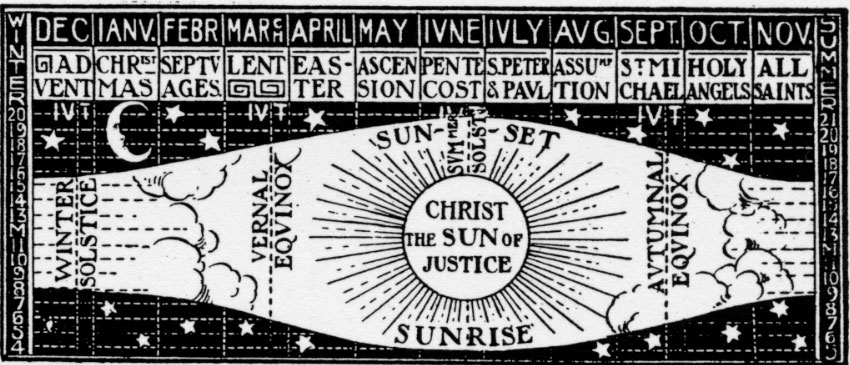

|
The Liturgical Year X |
|
||
|
The Current Season: The Time After Pentecost 2. The Time After Pentecost Schema 3.The Time After Pentecost Customs 4. The Time After Pentecost Foods
Other Seasons:
Special Illustrations! Medieval illuminations for the entire liturgical year along with an explanation of their symbolism can be found throughout these pages. Simply click on the caption under one of these illuminations for more information.
|
General Introduction Let the Catholic who reads this work be on his guard against that coldness of faith and that want of love which have well-nigh turned into an object of indifference that admirable cycle of the Church, which heretofore was, and always ought to be, the joy of the people, the source of light to the learned, and the book of the humblest of the faithful. - Abbot Gueranger, O.S.B., The Liturgical Year
One of the chief ways that the Church teaches and reteaches the deposit of Faith is through its liturgical cycle. The calendar of the Church, which takes its point of departure from the natural seasons, the Old Law and the New, stretches out over a twelve-month period the divine things that are present in a condensed form in every single Mass. This distension of the mysteries over the course of a year allows the faithful to appropriate, gradually and solemnly, the deeper meaning of their faith. Just as the observant eye learns how to read the inner workings of nature from the changing signs of the season, so too does the pious eye learn the essence of supernature from the rhythms of the liturgical calendar. Dom Gueranger is right: the Church calendar is a book, a book filled with mystagogical signs and hints which, if read properly and attentively, disclose the full light of Christian wisdom. What is more, reading this "book" precipitates an annual renewal of, or re-initiation into, the whole of our Christian faith, from our fall into sin to our redemption in Christ, from our faltering attempts at holiness to our joyful if not anxious anticipation of contemplating God face to face. The liturgical calendar is therefore not only something that illuminates our minds, but inflames our hearts. According to Plato's Republic the perfect city is one in which citizens experience identical pleasures and pains at the same time, as if the whole community were a single body wincing or delighting in unison. The Church calendar is the fulfillment of that philosophical ideal. From the exilic pining of Septuagesima to the austerity of Lent, from the grief of Passiontide to the jubilance of the Pasch, the Church, by staggering its feasts and observances in a particular order, enables the faithful to experience a number of holy feelings as one. Indeed, the emotional range of the traditional Roman rite is perhaps the most variegated in all of Christendom. Complex emotions, such as joy-in-penitence (Laetare and Gaudete Sundays) or penitence-in-joy (the lesser Rogation Days), are not uncommon. Hopeful sorrow, jubilant fasting, cathartic anguish: all find their home in the preconciliar Roman calendar. By ordering and harmonizing our emotions in such a way, this affective panoply serves an important purpose. As David Mills recently wrote in the New Oxford Review, "You are in training for heaven, and therefore you do not always get what you want at the moment, as you can do in revivalist Protestantism, but rather what you need for eternity-- and the restraint on your desires is part of that training for eternity" ("Emotionalism or Ritualism," 12/99). It is because immersion in the liturgical cycle is so important that we include this section on the meaning of the seasons and the traditional customs that have helped carry them from the church into the home. And we find this endeavor most rewarding, as the old Church calendar is particularly resplendent with the kinds of signs, compasses, and emotional bookmarks so conducive to Christian sanctification. It is our hope that this section will not only deepen our love for "that admirable cycle of the Church," but will encourage the appropriation of the calendar's external observances and internal teachings. |
||